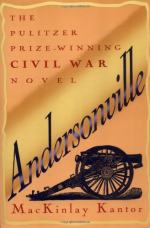Stiggall died in June. He was one of the first victims of scurvy, which, in the succeeding few weeks, carried off so many. All of us who had read sea-stories had read much of this disease and its horrors, but we had little conception of the dreadful reality. It usually manifested itself first in the mouth. The breath became unbearably fetid; the gums swelled until they protruded, livid and disgusting, beyond the lips. The teeth became so loose that they frequently fell out, and the sufferer would pick them up and set them back in their sockets. In attempting to bite the hard corn bread furnished by the bakery the teeth often stuck fast and were pulled out. The gums had a fashion of breaking away, in large chunks, which would be swallowed or spit out. All the time one was eating his mouth would be filled with blood, fragments of gums and loosened teeth.
Frightful, malignant ulcers appeared in other parts of the body; the ever-present maggot flies laid eggs in these, and soon worms swarmed therein. The sufferer looked and felt as if, though he yet lived and moved, his body was anticipating the rotting it would undergo a little later in the grave.
The last change was ushered in by the lower parts of the legs swelling. When this appeared, we considered the man doomed. We all had scurvy, more or less, but as long as it kept out of our legs we were hopeful. First, the ankle joints swelled, then the foot became useless. The swelling increased until the knees became stiff, and the skin from these down was distended until it looked pale, colorless and transparent as a tightly blown bladder. The leg was so much larger at the bottom than at the thigh, that the sufferers used to make grim jokes about being modeled like a churn, “with the biggest end down.” The man then became utterly helpless and usually died in a short time.
The official report puts down the number of deaths from scurvy at three thousand five hundred and seventy-four, but Dr. Jones, the Rebel surgeon, reported to the Rebel Government his belief that nine-tenths of the great mortality of the prison was due, either directly or indirectly, to this cause.
The only effort made by the Rebel doctors to check its ravages was occasionally to give a handful of sumach berries to some particularly bad case.
When Stiggall died we thought Emerson would certainly follow him in a day or two, but, to our surprise, he lingered along until August before dying.
CHAPTER XXXII.
“Ole boo,” And “Ole Sol, the Haymaker”—A fetid, burning desert—noisome water, and the effects of drinking it—stealing soft soap.
The gradually lengthening Summer days were insufferably long and wearisome. Each was hotter, longer and more tedious than its predecessors. In my company was a none-too-bright fellow, named Dawson. During the chilly rains or the nipping, winds of our first days in prison, Dawson would, as he rose in, the morning, survey the forbidding skies with lack-luster eyes and remark, oracularly:




